Integrating Ecommerce Help Desk for Business Growth
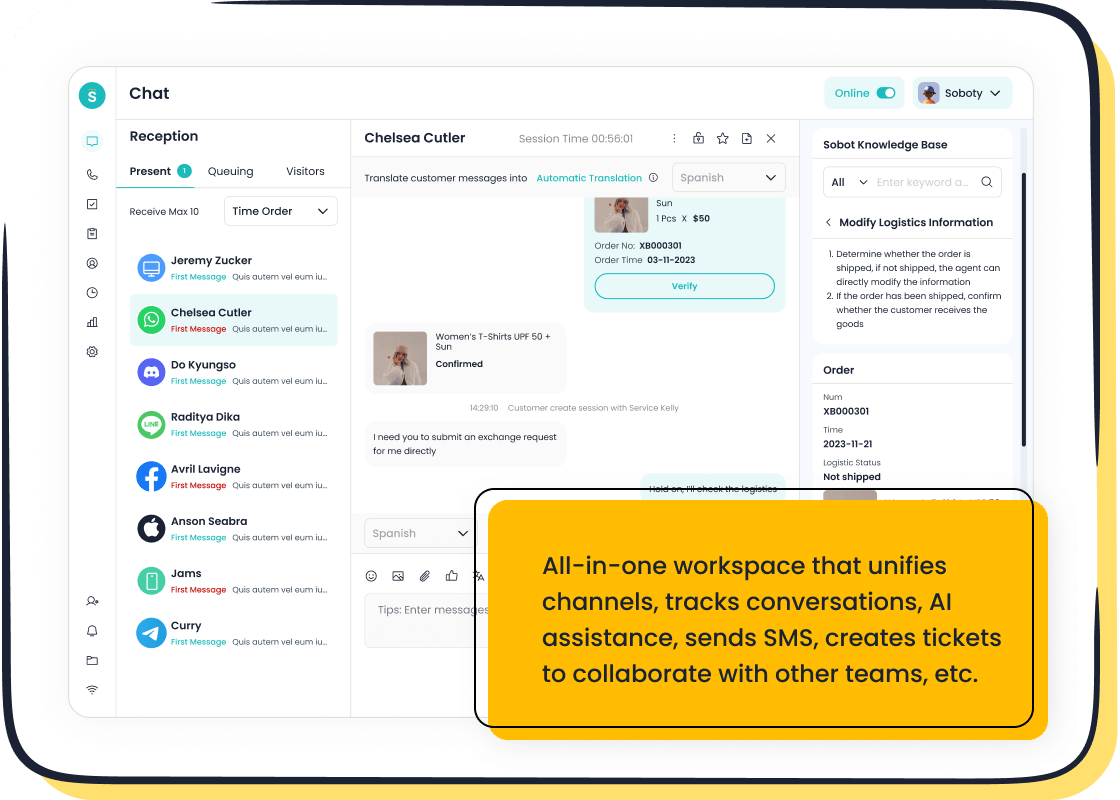
Great customer service isn’t just a perk—it’s a growth driver. Businesses that prioritize it can see revenue grow by 4% to 8% above their market. Even a 5% increase in customer retention boosts profits by up to 95%. That’s where ecommerce help desk software comes in. Tools like Sobot’s Live Chat go beyond answering questions. They unify customer interactions, reduce waiting times by 35%, and scale effortlessly with your business. When your service improves, so does your bottom line. Ready to transform how you connect with customers?
Understanding Ecommerce Help Desk Software
What Is Ecommerce Help Desk Software
Think of ecommerce help desk software as your all-in-one toolkit for managing customer interactions. It’s not just about answering questions—it’s about creating a seamless experience for your customers. This software combines ticketing systems with AI to route tickets, provide real-time order updates, and even automate workflows. It helps your team focus on what matters most: solving problems quickly and building relationships.
You’ll also find features like self-service options, including knowledge bases and FAQs. These tools empower your customers to find answers on their own, reducing the need for a large support team. Whether you’re dealing with a flood of inquiries during a sale or managing day-to-day questions, this software ensures timely and efficient responses.
In short, ecommerce help desk software is essential for businesses that rely on repeat customers. It keeps your operations smooth and your customers happy.
Key Features That Drive Ecommerce Success
What makes a help desk tool truly stand out? It’s the features that directly impact your business growth. For starters, sales volume and conversion rates are key indicators of success. A robust help desk software supports these metrics by offering tools like live chat, automated responses, and customer segmentation.
Customer loyalty is another big one. Features like integrated analytics and personalized service help you understand your customers better, boosting repeat purchase rates and lifetime value. And let’s not forget website traffic insights. By analyzing where your visitors come from, you can tailor your marketing strategies to drive even more engagement.
When you combine these features, you’re not just improving customer service—you’re setting your business up for long-term success.
The Role of Help Desk Software in Ecommerce Customer Service
Ecommerce customer service is the backbone of your business. Help desk software plays a huge role in making it stronger. For example, companies like Gorgias and Princess Polly have used these tools to cut response times by over 90%, even during peak seasons. That’s the kind of efficiency that keeps customers coming back.
Automation is another game-changer. By handling repetitive tasks, your team can focus on high-value interactions. This not only improves customer satisfaction but also boosts your team’s productivity. And when everything is centralized—whether it’s emails, chats, or social media messages—your agents can resolve issues faster and more effectively.
With help desk software, you’re not just solving problems—you’re building trust and loyalty with every interaction.
Benefits of Ecommerce Help Desk Integration
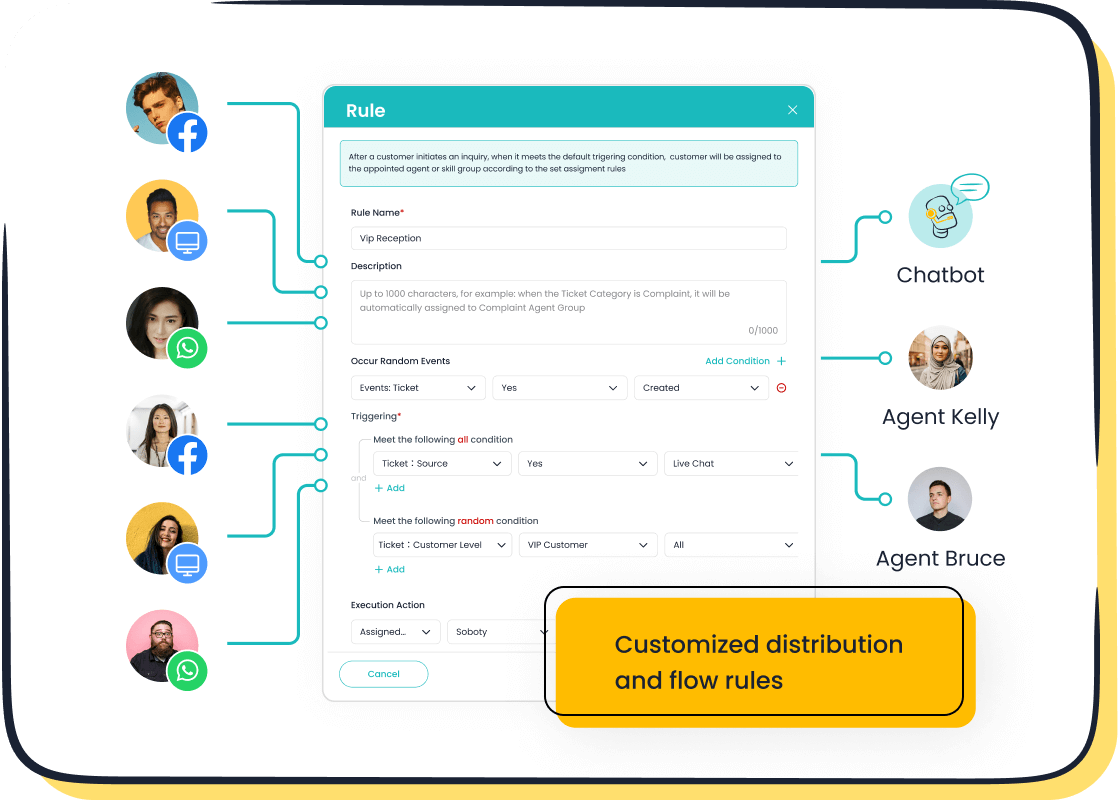
Enhancing Customer Support with Tools Like Sobot Live Chat
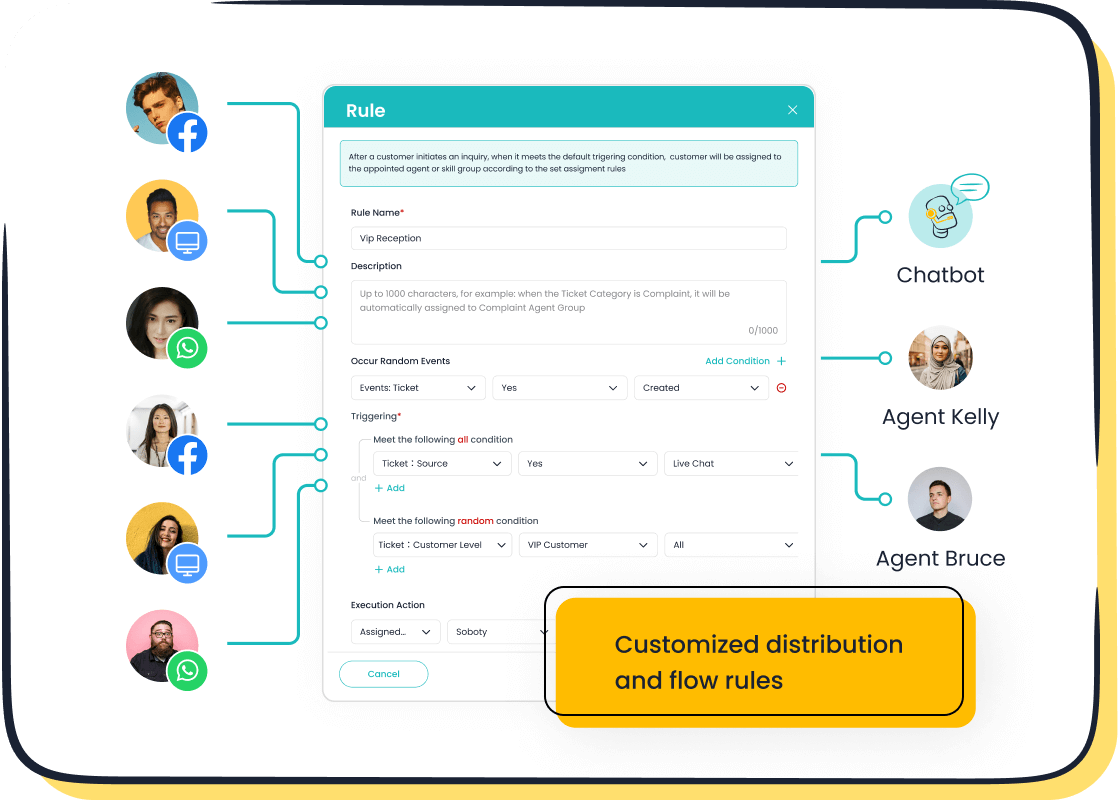
Imagine a customer visiting your online store and needing help instantly. With tools like Sobot Live Chat, you can provide real-time support that keeps them engaged. This platform connects with customers on their preferred channels—whether it’s WhatsApp, Instagram, or your website—ensuring no query goes unanswered.
Sobot Live Chat doesn’t just answer questions; it transforms how you handle customer support. Its AI-powered tools segment customers based on their needs, allowing your team to deliver personalized service. For example, if a visitor is browsing high-value products, the system can prioritize their inquiry for faster resolution. This tailored approach boosts customer satisfaction and loyalty.
What’s more, Sobot Live Chat’s analytics evaluate over 150 indicators, helping you optimize your ecommerce customer service strategy. Businesses using this tool have reported a 38% increase in conversion rates, turning casual visitors into loyal customers. By integrating such advanced help desk software, you’re not just solving problems—you’re building lasting relationships.
Streamlining Operations for Greater Efficiency
Running an ecommerce business means juggling multiple tasks. Integrating an ecommerce help desk simplifies your operations by centralizing customer interactions into one platform. Tools like Sobot Live Chat unify messages from social media, email, and websites, ensuring your team doesn’t miss a single request.
Automation plays a big role here. Features like ticketing systems and intelligent assignment reduce response times and free up your team to focus on growth-oriented tasks. For instance, automated workflows can handle repetitive queries, allowing agents to concentrate on complex issues. This streamlined approach improves productivity and reduces operational bottlenecks.
Let’s look at some numbers:
| Efficiency Metric | Before Streamlining | After Streamlining |
|---|---|---|
| Processing Time | 45 minutes | 30 minutes |
| Customer Satisfaction Rate | 75% | 90% |
| Employee Productivity | 80% | 95% |
| Error Rate in Operations | 20% | 5% |
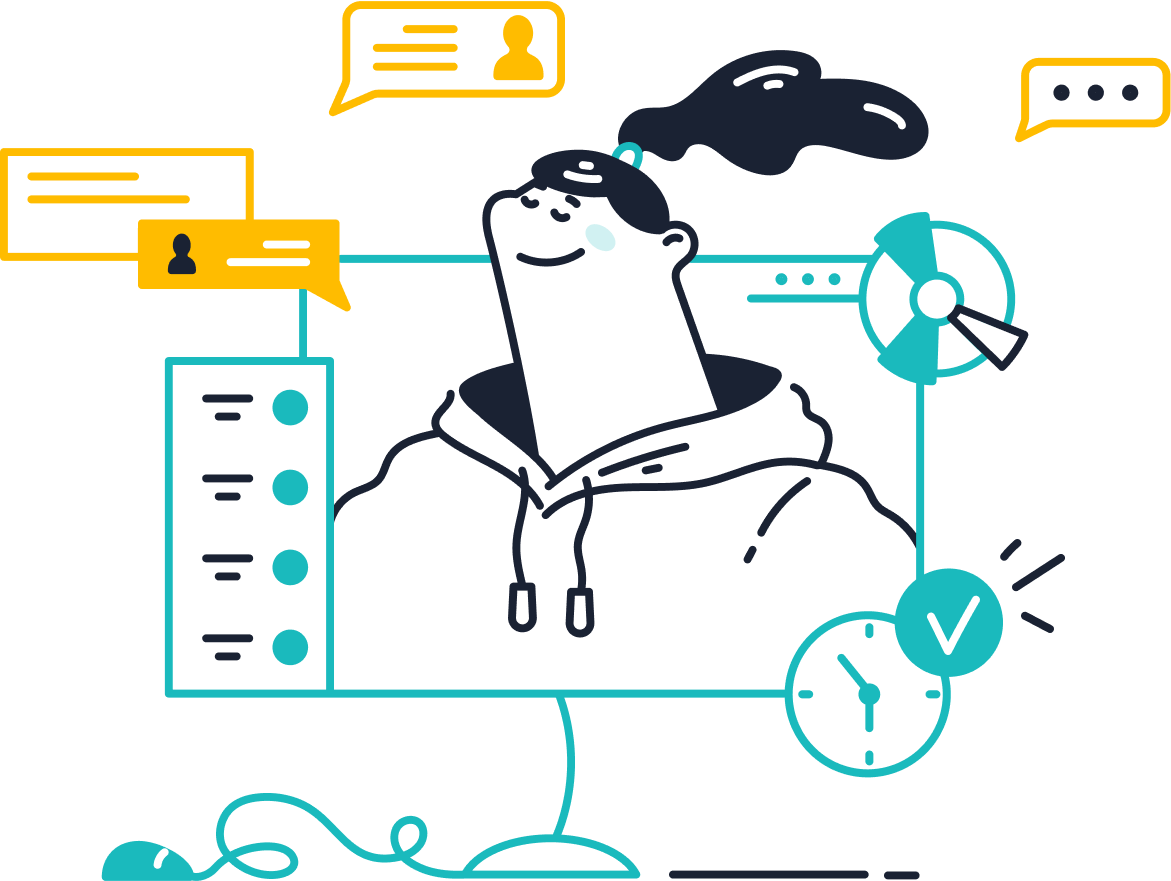
These improvements show how streamlining operations enhances both customer service and internal workflows. By adopting tools like Sobot Live Chat, you can achieve similar results, making your business more efficient and scalable.
Leveraging Data Insights for Strategic Growth
Data is the backbone of smart decision-making. Ecommerce help desk systems like Sobot Live Chat provide advanced analytics that reveal customer behavior, market trends, and operational performance. These insights empower you to refine your strategies and drive growth.
For example, imagine analyzing customer segmentation data to tailor your marketing campaigns. A mid-sized ecommerce company did just that, improving sales by 30% in six months. By understanding purchasing behavior and demographics, they created personalized offers that resonated with their audience.
Effective inventory management is another benefit. Data analytics help forecast stock levels accurately, preventing overstock or understock issues. This optimization reduces costs and enhances customer satisfaction.
| Evidence Description | Insight Type |
|---|---|
| Monitoring cart abandonment rates provides insights for enhancing user experience. | User Experience Optimization |
| Understanding user behavior through A/B testing can significantly improve conversion | Conversion Rate Optimization |
| rates, increasing revenue without needing more traffic. | |
| Leveraging data allows for personalized shopping experiences that resonate with | Customer Personalization |
| online shoppers. |
By leveraging these insights, you can make informed decisions that align with your business goals. Tools like Sobot Live Chat don’t just improve customer support—they help you grow strategically.
Scaling Customer Support for Business Expansion
When your business starts growing, scaling customer support becomes essential. You can’t afford to let your service quality drop as your customer base expands. That’s where smart tools like Sobot Live Chat come into play. They help you handle more inquiries without overwhelming your team. But scaling isn’t just about adding more agents—it’s about working smarter.
Why Scaling Matters for Growth
Scaling your customer service ensures that every customer feels valued, no matter how big your business gets. Imagine this: You’ve launched a new product, and your website traffic doubles overnight. Without a scalable system, your team might struggle to keep up. Delayed responses or missed queries can lead to frustrated customers and lost sales. On the other hand, a well-scaled support system keeps everything running smoothly, even during peak times.
Here’s how scaling impacts your business growth:
| Metric | Importance in Scaling |
|---|---|
| Customer Acquisition Cost (CAC) | Tracks how efficiently you’re spending to gain new customers as your business grows. |
| Customer Lifetime Value (LTV) | Shows the long-term value of your customers, helping you balance acquisition costs. |
| Monthly Recurring Revenue (MRR) | Measures predictable revenue growth, a key indicator of successful scaling. |
| Churn Rate | Reflects how satisfied your customers are and how well you’re retaining them. |
| Gross Margin | Assesses whether your growth is profitable and sustainable. |
These metrics highlight why scaling isn’t just a nice-to-have—it’s a must for sustainable growth.
How Tools Like Sobot Live Chat Help You Scale
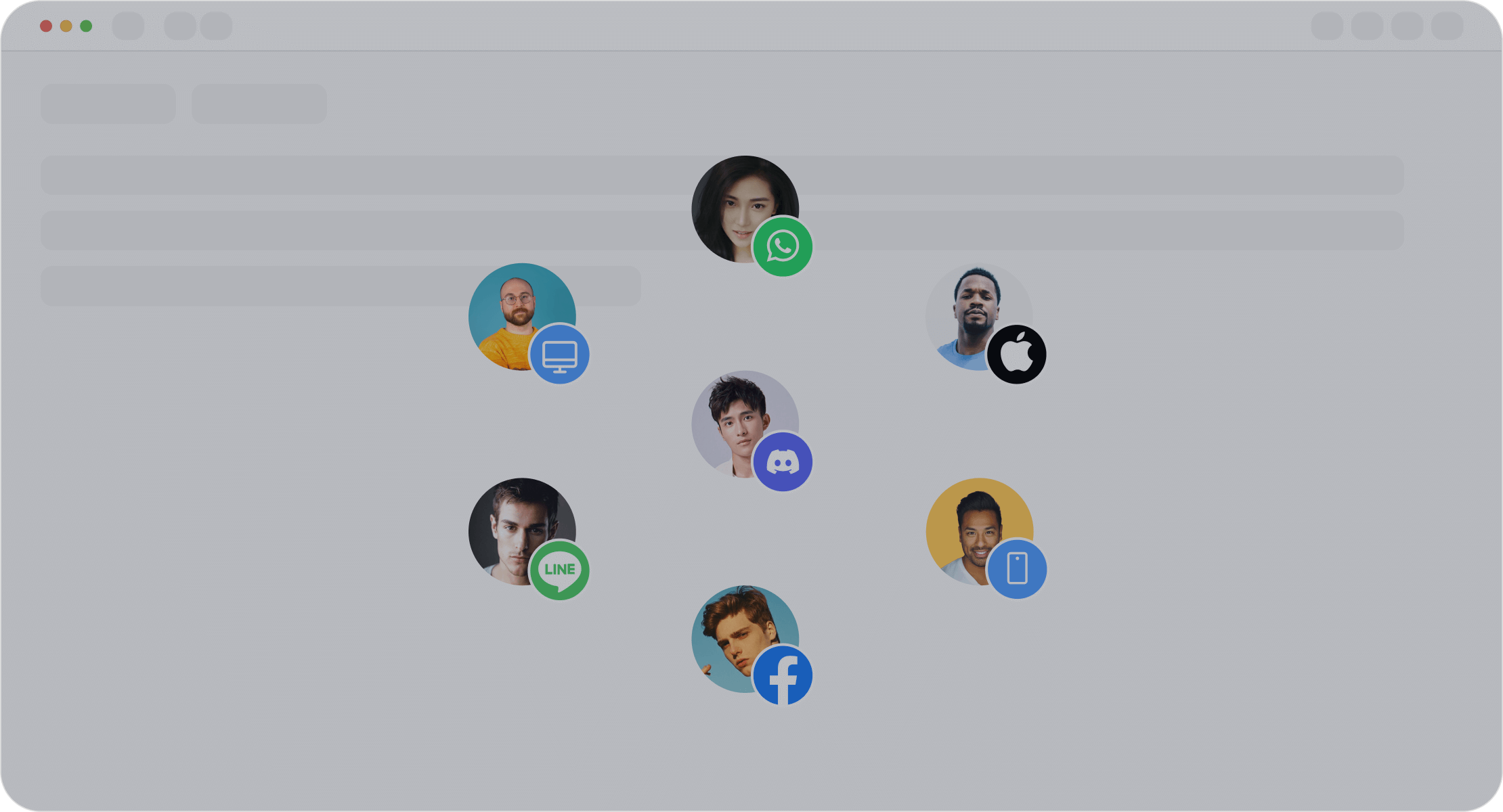
Scaling doesn’t mean you need to hire dozens of new agents. Instead, you can use tools that make your existing team more efficient. Sobot Live Chat is a perfect example. It centralizes all your customer interactions—whether they come from WhatsApp, Instagram, or your website—into one platform. This unified approach saves time and ensures no query slips through the cracks.
Automation is another game-changer. Sobot Live Chat uses AI to handle repetitive tasks like answering FAQs or routing tickets. This frees up your team to focus on more complex issues. Plus, its intelligent assignment feature ensures that the right agent handles the right query, improving resolution times.
Building a Better Customer Experience
Scaling isn’t just about handling more inquiries—it’s about improving the customer experience. When your support system grows with your business, customers notice. They get faster responses, more personalized service, and a smoother overall experience. This builds trust and loyalty, turning one-time buyers into lifelong customers.
For example, imagine a customer reaching out during a busy holiday season. With Sobot Live Chat, they get instant help, even if your team is swamped. The system’s AI tools can prioritize urgent queries, ensuring no one feels ignored. This kind of proactive support leaves a lasting impression.
By scaling your customer support effectively, you’re not just keeping up with growth—you’re driving it. Happy customers are more likely to recommend your business, boosting your reputation and attracting even more buyers.
Steps to Integrate Ecommerce Help Desk Software
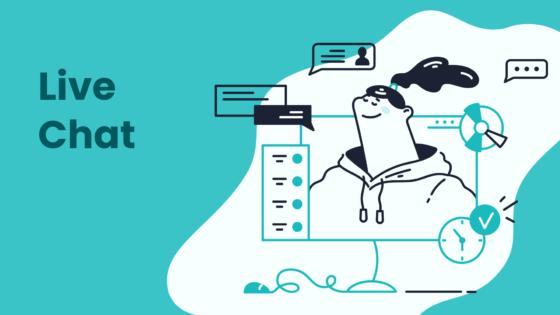
Assessing Your Business Needs and Goals
Before diving into integration, you need to understand your business inside out. What are your pain points? Where does your current customer service process fall short? Start by taking inventory of your tech setup. List all hardware, software, and network components. This helps you identify gaps and areas where your tools might be holding you back.
Next, think about your goals. Are you aiming to improve customer retention or reduce response times? Maybe you want to offer multichannel support or introduce self-service options. Mapping these objectives to IT solutions ensures you’re choosing the right tools for the job. For example, if your goal is faster ticket resolution, look for software that offers automation and analytics.
Tracking performance is equally important. Help desk software should provide insights into metrics like ticket resolution times and customer satisfaction rates. These data points let you set clear KPIs and measure how well your team is meeting objectives.
Tip: Write down your top three business goals and match them with specific features in your help desk software. This ensures your investment aligns with your needs.
Selecting the Right Software: Why Sobot Stands Out
Choosing the right software can feel overwhelming, but Sobot makes the decision easier. It’s not just a help desk tool—it’s an all-in-one solution designed to simplify customer support.
Here’s how Sobot compares to competitors:
| Feature | Sobot | Competitors |
|---|---|---|
| All-in-One Solution | Yes | No (single core products) |
| Timely Service | Available | Varies (not always accessible) |
| Cost-Effectiveness | Half or lower than others | Generally higher prices |
| Integration of Channels | Yes | Limited to specific channels |
Sobot’s omnichannel capabilities let you connect with customers across platforms like WhatsApp, Instagram, and Telegram. This ensures seamless integration with shopping platforms and no missed queries. Plus, its AI-powered tools boost efficiency by automating repetitive tasks.
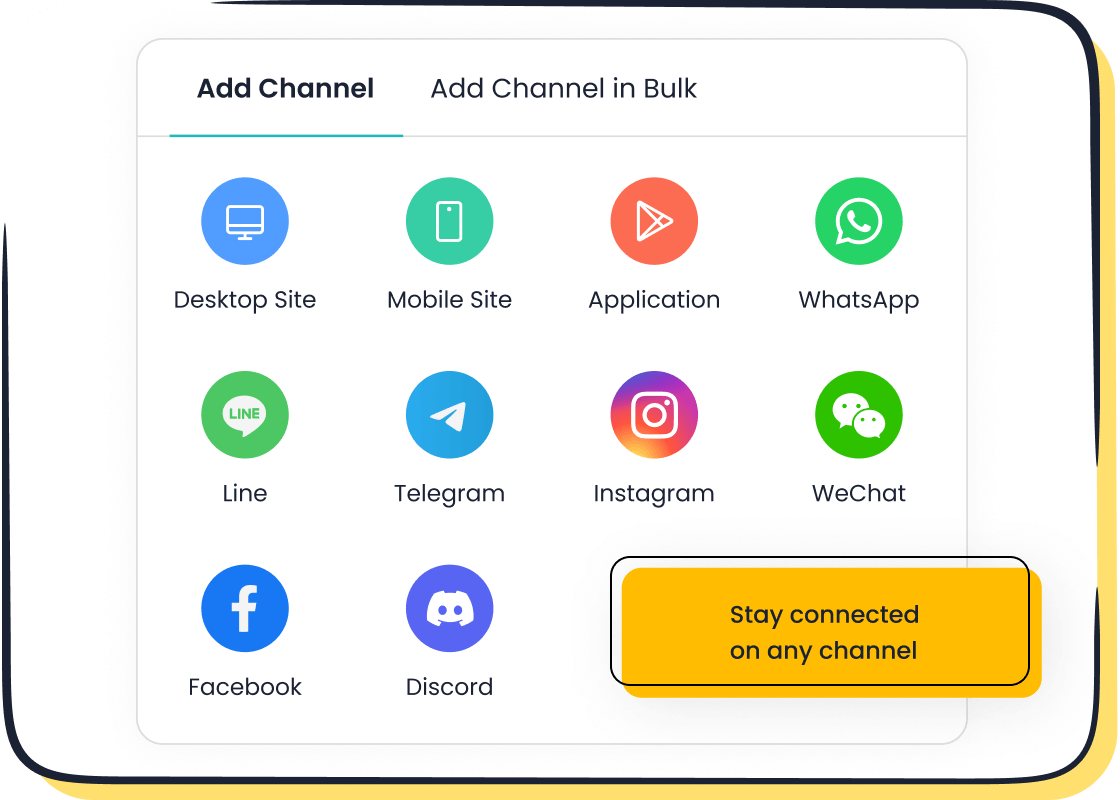
Cost-effectiveness is another standout feature. Sobot offers advanced functionality at half the price of many competitors. This makes it ideal for businesses looking to scale without breaking the bank.
Note: Sobot’s Live Chat feature doesn’t just unify customer interactions—it improves conversion rates by 38%. That’s a game-changer for ecommerce businesses.
Planning and Implementing Seamless Integration
Once you’ve chosen your software, it’s time to plan the integration. Start by outlining the steps. What systems need to be connected? Which teams will use the software? Clear planning prevents hiccups during implementation.
Take inspiration from companies like NVISO and WirelessCar, which successfully integrated tools like Exalate to streamline operations. For example:
| Organization | Integration Tool | Benefits Achieved |
|---|---|---|
| NVISO | Exalate | Improved ITSM integration with clients |
| WirelessCar | Exalate | Streamlined collaborations with automotive brands |
| DPG Media | Jira | Migrated data from Zendesk to Jira |
| Quorum Cyber | Exalate | Enhanced cybersecurity operations, integrating 500+ tickets monthly |
Training is another critical step. Your team needs to understand how to use the software effectively. Sobot offers intuitive interfaces and AI-assisted tools, making the learning curve manageable.
Finally, monitor the integration’s performance. Use analytics to track metrics like ticket resolution times and customer satisfaction. This helps you identify areas for improvement and optimize your setup over time.
Pro Tip: Schedule regular check-ins with your team post-integration to ensure everything runs smoothly and address any challenges early.
Training Teams for Effective Use of Tools Like Live Chat
Your team is the backbone of your customer service strategy. Training them to use tools like Sobot Live Chat effectively can transform how you handle customer support. But where do you start?
Step 1: Familiarize Your Team with the Platform
Begin by introducing your team to the features of Sobot Live Chat. Show them how the unified workspace consolidates customer interactions from platforms like WhatsApp, Instagram, and Telegram. Highlight the AI-assisted tools that automate repetitive tasks, freeing up time for more complex queries.
Tip: Use hands-on workshops or interactive tutorials to make the learning process engaging.
Step 2: Focus on Customer Service Best Practices
Training isn’t just about learning the software—it’s about mastering customer service best practices. Teach your team how to personalize responses, prioritize urgent queries, and use analytics to improve service quality. For example, Sobot Live Chat’s built-in analytics can help agents identify trends and adjust their approach to meet customer needs.
Step 3: Role-Playing Scenarios
Role-playing is a great way to prepare your team for real-world situations. Create scenarios where they handle inquiries using Sobot Live Chat. For instance, simulate a high-traffic event like a holiday sale and let them practice managing multiple queries simultaneously.
Step 4: Continuous Learning
Customer service evolves, and so should your team. Encourage ongoing training sessions to keep them updated on new features and industry trends. Sobot’s intuitive interface makes it easy for agents to adapt to updates without a steep learning curve.
Callout: A well-trained team doesn’t just resolve issues—they build trust and loyalty with every interaction.
Monitoring and Optimizing Performance Over Time
Once your help desk software is up and running, monitoring its performance is crucial. This ensures your customer support remains efficient and effective as your business grows.
Key Metrics to Track
Use Sobot Live Chat’s analytics to monitor essential metrics:
| Metric | Description |
|---|---|
| Ticket volume | Tracks the number of incoming service requests, helping you assess workload and staffing needs. |
| Response time | Measures how quickly your team replies to queries, directly impacting customer satisfaction. |
| Resolution time | Evaluates how long it takes to resolve issues, reflecting the overall customer experience. |
These metrics provide a clear picture of your team’s performance and highlight areas for improvement.
Leveraging Feedback for Optimization
Customer feedback is a goldmine for insights. Satisfaction surveys, a feature in Sobot Live Chat, help you gauge how well your team is meeting expectations. If customers consistently rate certain interactions poorly, it’s a sign to refine your approach.
Pro Tip: Use feedback to improve your self-service options, like FAQs and knowledge bases. This reduces the workload on your team while enhancing customer satisfaction.
Adapting to Trends
Customer needs change over time. Regularly analyze data from Sobot Live Chat to identify emerging trends. For example, if ticket volume spikes during product launches, consider scaling your team or automating more tasks.
Continuous Improvement
Optimization isn’t a one-time task—it’s ongoing. Schedule monthly reviews to assess metrics like customer retention rates and knowledge base effectiveness. Use these insights to tweak your strategy and keep your customer service ahead of the curve.
By monitoring and optimizing performance, you’re not just maintaining service quality—you’re setting the stage for long-term growth.
Overcoming Common Integration Challenges
Addressing Resistance to Change
Change can be tough, especially when it involves new technology. Employees might feel uncertain or worry about how their roles will shift. In fact, 38% of employees hesitate due to uncertainty, while 27% resist because of job role changes. These numbers show how common resistance is during help desk integration.
So, how do you tackle this? Start by involving your team early. When employees feel included in decisions, they’re more likely to embrace the change. Clear communication is also key. Without it, 29% of employees report feeling lost, and 64% rely on leaders for direction. Regular updates and training sessions can ease concerns and build confidence.
Here’s a quick look at common resistance types:
| Challenge/Resistance Type | Percentage |
|---|---|
| Employees hesitant due to uncertainty | 38% |
| Employees resisting due to job role changes | 27% |
| Employees feeling excluded from decisions | 23% |
| Executives citing failure to adapt models | 37% |
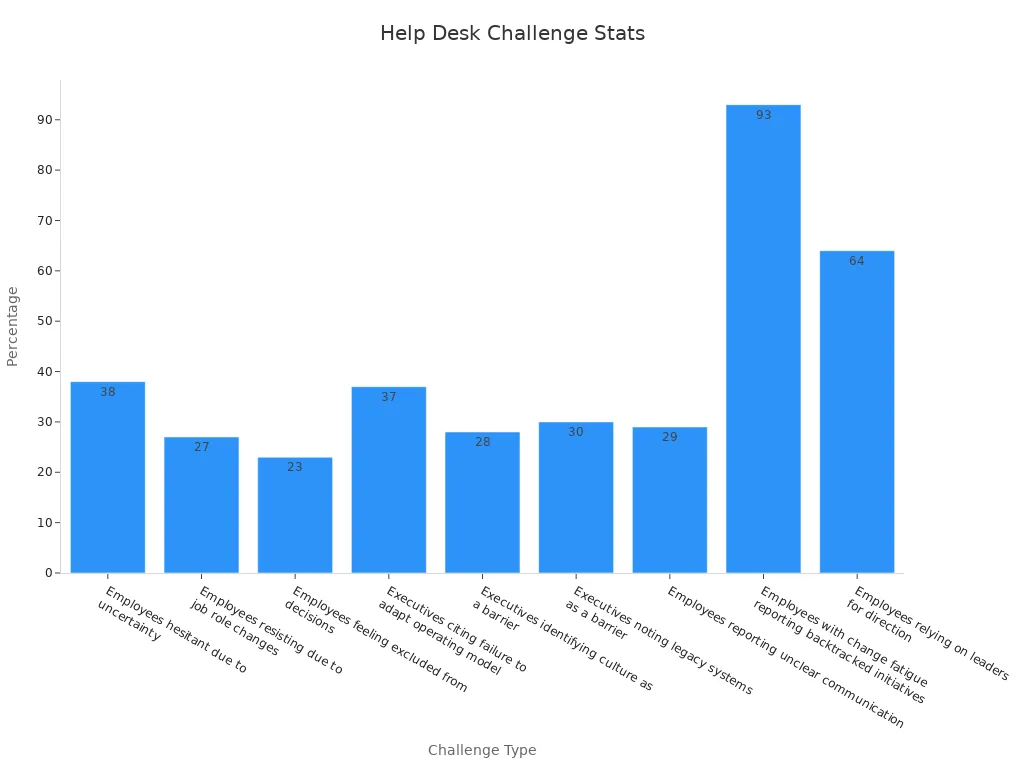
By addressing these challenges head-on, you can create a smoother transition for your team.
Ensuring Compatibility with Existing Systems
Integrating new software with your current setup can feel like solving a puzzle. You need to ensure everything fits perfectly. Start by reviewing your e-commerce platform’s documentation. This helps you confirm compatibility and avoid inefficiencies. For example, tools like Sobot Live Chat offer seamless integration with platforms like Shopify and Salesforce, ensuring smooth workflows.
Here are some key aspects to evaluate:
| Aspect | Description |
|---|---|
| Functionality | Ensure the integration scales with your business growth. |
| Compatibility | Confirm it matches your e-commerce platform’s requirements. |
| Data Synchronization | Evaluate how well data flows between systems. |
| Customization | Check if the software supports extensions and tailored configurations. |
Skipping these steps can lead to broken workflows or navigation issues. By ensuring compatibility, you’ll save time and avoid headaches down the road.
Managing Data Security and Privacy Concerns
Data security is non-negotiable. A single breach can cost your business millions and destroy customer trust. In the U.S., the average cost of a data breach exceeds $4 million. Beyond financial loss, compliance violations can disrupt operations and tarnish your reputation.
To protect your data, focus on these best practices:
- Use secure communication protocols like HTTPS.
- Implement robust identity management systems.
- Ensure API security to guard against cyberattacks.
Sobot’s solutions prioritize security, offering features like encrypted communication and role-based access controls. These measures help you safeguard sensitive information while maintaining compliance with regulations.
| Evidence Type | Description |
|---|---|
| Financial Loss | The average cost of a data breach in the US is over $4 million. |
| Reputational Damage | A serious data breach can destroy brand equity and customer trust. |
| Compliance Violations | Data breaches can result in legal exposure and compliance issues. |
By addressing these concerns proactively, you can build a secure foundation for your help desk integration.
Balancing Costs with Long-Term Benefits
When you’re integrating ecommerce help desk software, balancing costs with long-term benefits is key. It’s tempting to focus on upfront expenses, but looking at the bigger picture can save you money and headaches down the road. So, how do you make sure your investment pays off?
Start with a cost-benefit analysis (CBA). This method helps you weigh the financial costs against the rewards, but it doesn’t stop there. It also considers intangible factors like employee morale and customer satisfaction. These elements might not show up on a spreadsheet, but they’re crucial for long-term success. For example, happier employees work more efficiently, and satisfied customers stick around longer.
Tip: Don’t rush your analysis. Extend your timeframe to include long-term impacts. Immediate savings might look good now, but they could cost you more later.
Here’s how you can avoid common pitfalls in your cost-benefit analysis:
- Confirmation bias: Assign someone to play devil’s advocate and challenge assumptions.
- Neglecting intangible factors: Use structured methods to quantify things like customer loyalty or team productivity.
- Narrow timeframes: Look beyond the next quarter. Include projections for the next year or two.
You can also enhance your decision-making by combining CBA with strategic alignment frameworks. These frameworks ensure your choices match your business goals. Risk assessment matrices help you manage uncertainties, while stakeholder impact analysis gives you a broader perspective.
Callout: Think of your help desk software as an investment in growth. Tools like Sobot Live Chat don’t just improve customer service—they boost conversion rates and streamline operations, delivering value far beyond their initial cost.
Balancing costs with long-term benefits isn’t just smart—it’s essential. By taking a thoughtful approach, you’ll set your business up for sustainable success.
Long-Term Strategies for Maximizing Impact
Regular Updates and Customization of Tools
Your help desk software isn’t a “set it and forget it” solution. Regular updates and customization keep it aligned with your business needs. As your company grows, your customer service tools should evolve too. For example, adding new features like AI-powered chatbots or integrating with emerging platforms can enhance efficiency and customer satisfaction.
Sobot Live Chat makes this process seamless. Its customizable widgets let you match the tool to your brand’s image, creating a cohesive experience for your customers. You can also tweak workflows to address specific challenges, like prioritizing high-value customers during peak shopping seasons. These small adjustments can have a big impact on your service quality.
Tip: Schedule quarterly reviews of your help desk tools. This ensures you’re using the latest features and adapting to changing customer expectations.
Using Customer Feedback to Refine Support
Listening to your customers is one of the easiest ways to improve your service. Feedback helps you identify what’s working and what needs fixing. For instance, asking for input right after a sale allows you to address issues before they escalate. This proactive approach not only prevents negative reviews but also boosts customer retention.
Here’s why feedback matters:
- It improves customer satisfaction and strengthens your reputation.
- It helps refine your content strategies, ensuring they resonate with your audience.
- It allows you to tackle problems directly, building trust and loyalty.
Sobot Live Chat simplifies this process with built-in satisfaction surveys. These tools let you gather insights effortlessly, helping you refine your support strategies over time. A responsive approach to feedback shows your customers you care, which strengthens their connection to your brand.
Leveraging Analytics for Continuous Improvement
Data is your secret weapon for staying ahead. Analytics reveal patterns and trends that help you make smarter decisions. For example, an e-commerce retailer improved its conversion rate by 35% using web analytics and customer surveys. These insights allowed them to tailor their strategies and meet customer expectations more effectively.
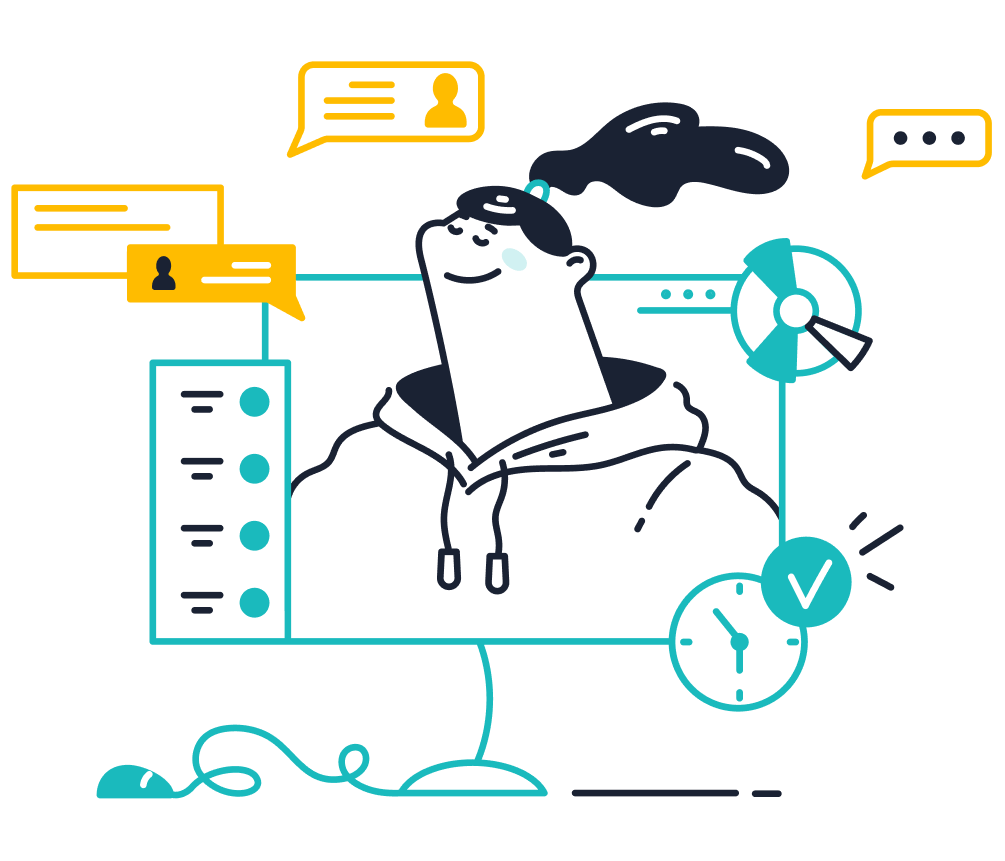
Sobot Live Chat takes analytics to the next level. It evaluates over 150 indicators, from response times to customer satisfaction scores. This data helps you identify bottlenecks and optimize your processes. Imagine spotting a spike in cart abandonment rates. With the right analytics, you can adjust your approach and recover those lost sales.
Callout: Businesses that embrace data-driven strategies see measurable results, like a 40% increase in qualified leads or a 20% reduction in missed deadlines. By leveraging analytics, you’re not just improving your service—you’re setting the stage for long-term growth.
Aligning Help Desk Goals with Business Objectives
Your help desk isn’t just a tool for solving customer problems. It’s a strategic asset that can drive your business forward when aligned with your overall goals. By connecting your help desk strategy to your business objectives, you create a seamless path to growth and customer satisfaction.
Start by focusing on customer experience. Every interaction should reflect your brand’s values and vision. For example, if your goal is to build loyalty, tools like Sobot Live Chat can help. Its AI-powered segmentation lets you personalize responses, making customers feel valued. This approach doesn’t just solve issues—it strengthens relationships.
Aligning your help desk with broader goals also means leveraging data. Modern ecommerce thrives on analytics. Tools like Sobot Live Chat evaluate over 150 indicators, helping you track performance and refine strategies. Imagine using these insights to improve response times or reduce cart abandonment rates. These small tweaks can lead to big wins.
Tip: Monitor metrics like customer satisfaction scores and ticket resolution times. They’re not just numbers—they’re a roadmap to better service.
Here’s why aligning help desk goals matters:
- It improves customer experience, boosting retention and loyalty.
- It enhances decision-making by integrating data analytics into your strategy.
- It ensures long-term success by focusing on goals that align with your brand vision.
- It helps track KPIs, giving you a clear picture of your progress.
Take a long-term view. Decisions made today should support your business for years to come. Whether you’re scaling operations or launching new products, your help desk should adapt to meet evolving needs. Sobot’s omnichannel solutions make this easy, connecting customer interactions across platforms like WhatsApp and Instagram.
By aligning your help desk goals with your business objectives, you’re not just improving customer service—you’re building a foundation for sustainable growth.
Integrating ecommerce help desk software is more than a tech upgrade—it’s a game-changer for your business. It boosts customer satisfaction, streamlines operations, and scales effortlessly as you grow. Tools like Sobot Live Chat make this transformation seamless by automating routine tasks, improving agent performance, and handling increased inquiries without compromising service quality.
Here’s a quick snapshot of the benefits:
| Benefit | Description |
|---|---|
| Automation of Routine Tasks | Reduces the time employees spend on repetitive tasks, allowing them to focus on more complex issues. |
| Improved Agent Performance | Tools like ticket prioritization and analytics enhance agent efficiency and service quality. |
| Scalability | The software can grow with the business, handling increased inquiries without sacrificing service quality. |
Proactive integration and continuous optimization are key to staying ahead. Did you know 93% of customers are likely to return to businesses with excellent service? Plus, reducing support requests by 20-30% frees your team to tackle bigger challenges. By adopting tools like Sobot Live Chat, you’re not just solving problems—you’re building loyalty and driving growth.
Tip: Start small, but think big. Every step toward better customer service is a step toward long-term success.
FAQ
What is the best way to start integrating ecommerce help desk software?
Start by identifying your business needs. List your goals, such as faster response times or better customer retention. Then, choose software like Sobot Live Chat that aligns with those goals. Planning and training your team ensure a smooth transition.
Tip: Write down your top three priorities to stay focused during the integration process.
How does Sobot Live Chat improve customer satisfaction?
Sobot Live Chat connects with customers on their favorite platforms, like WhatsApp or Instagram. It uses AI to personalize responses and prioritize urgent queries. This ensures faster resolutions and happier customers.
Emoji Insight: 🚀 Faster replies = 😊 Happier customers!
Can Sobot Live Chat handle multiple communication channels?
Yes! Sobot Live Chat supports websites, apps, and social media platforms like Facebook, Telegram, and Discord. It centralizes all interactions into one workspace, so your team never misses a message.
| Supported Channels | Examples |
|---|---|
| Social Media | WhatsApp, Instagram, Discord |
| Websites | E-commerce platforms |
Is Sobot Live Chat suitable for small businesses?
Absolutely! Sobot Live Chat is cost-effective and scalable. It automates repetitive tasks, saving time and resources. Small businesses can deliver top-notch service without needing a large team.
Note: Even small teams can achieve big results with the right tools.
Does Sobot Live Chat offer analytics?
Yes, it evaluates over 150 indicators, like response times and customer satisfaction. These insights help you optimize your strategies and improve performance.
Callout: Data-driven decisions lead to smarter growth. Use analytics to stay ahead of the competition.
See Also
Enhancing Sales Through Ecommerce Live Chat Solutions
Best Live Chat Tools for Ecommerce This Year
Utilizing Live Chat on Shopify for Retail Success